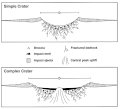| Bow City crater | |
|---|---|
| Impact crater/structure | |
| Confidence | Potential [1] |
| Diameter | ~8 kilometers (5.0 mi) |
| Age | ~73 Ma Late Cretaceous |
| Exposed | No |
| Location | |
| Location | Western Canadian Sedimentary Basin |
| Coordinates | 50°26′N112°24′W / 50.433°N 112.400°W |
| Country | Canada |
| Province | Alberta |
| Municipality | Bow City, Alberta |
The Bow City crater is a potential [1] meteorite impact crater located in southern Alberta, Canada. [2] [3] [4] [5]
Contents
The 8-kilometre-wide (5.0 mi) crater was discovered in 2012 by Wei Xie of the University of Alberta. The crater is estimated to have formed approximately 70 million years ago. The crater is not directly visible from the surface, as it is buried under approximately a kilometre of overburden. Petrochemical seismic studies provided the first clues to the existence of the crater.



